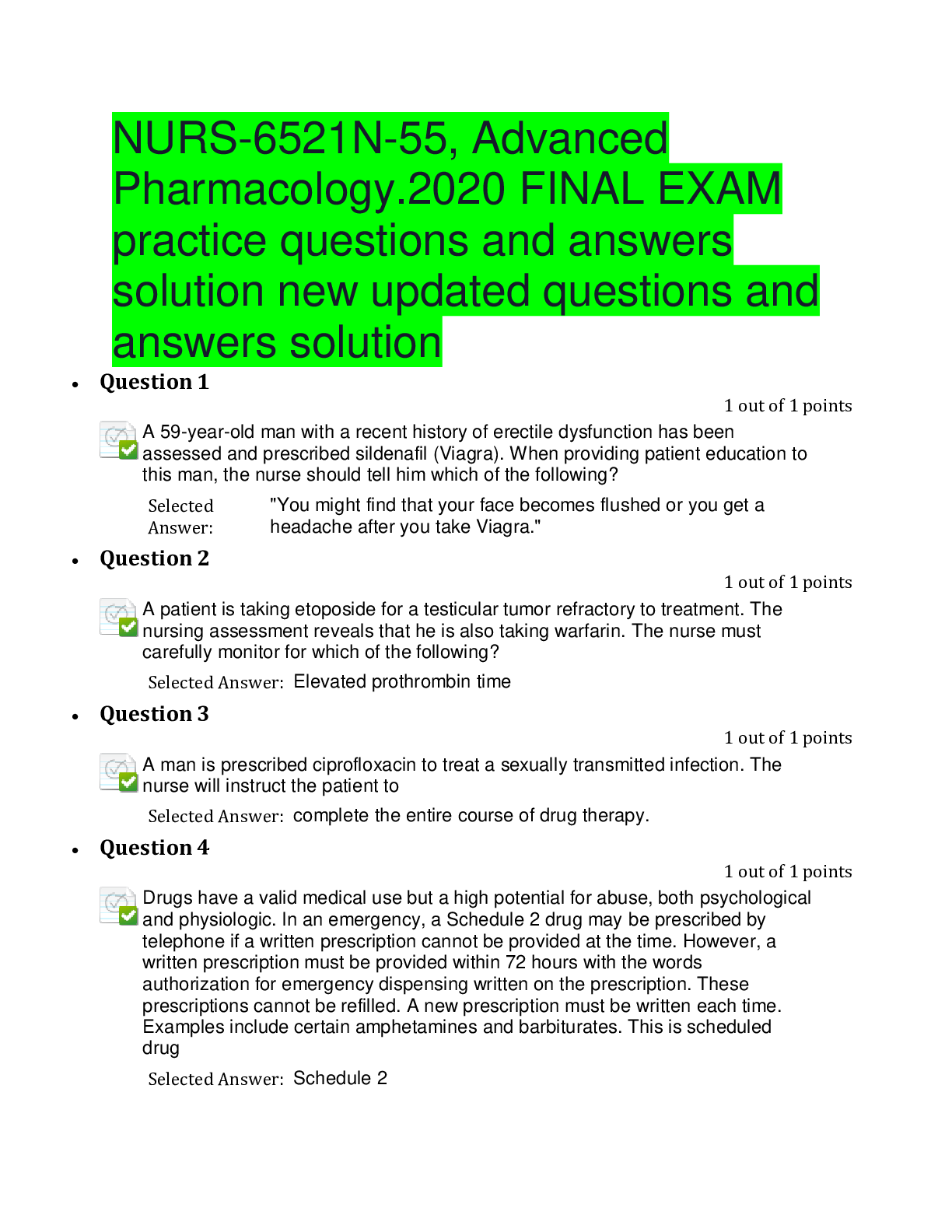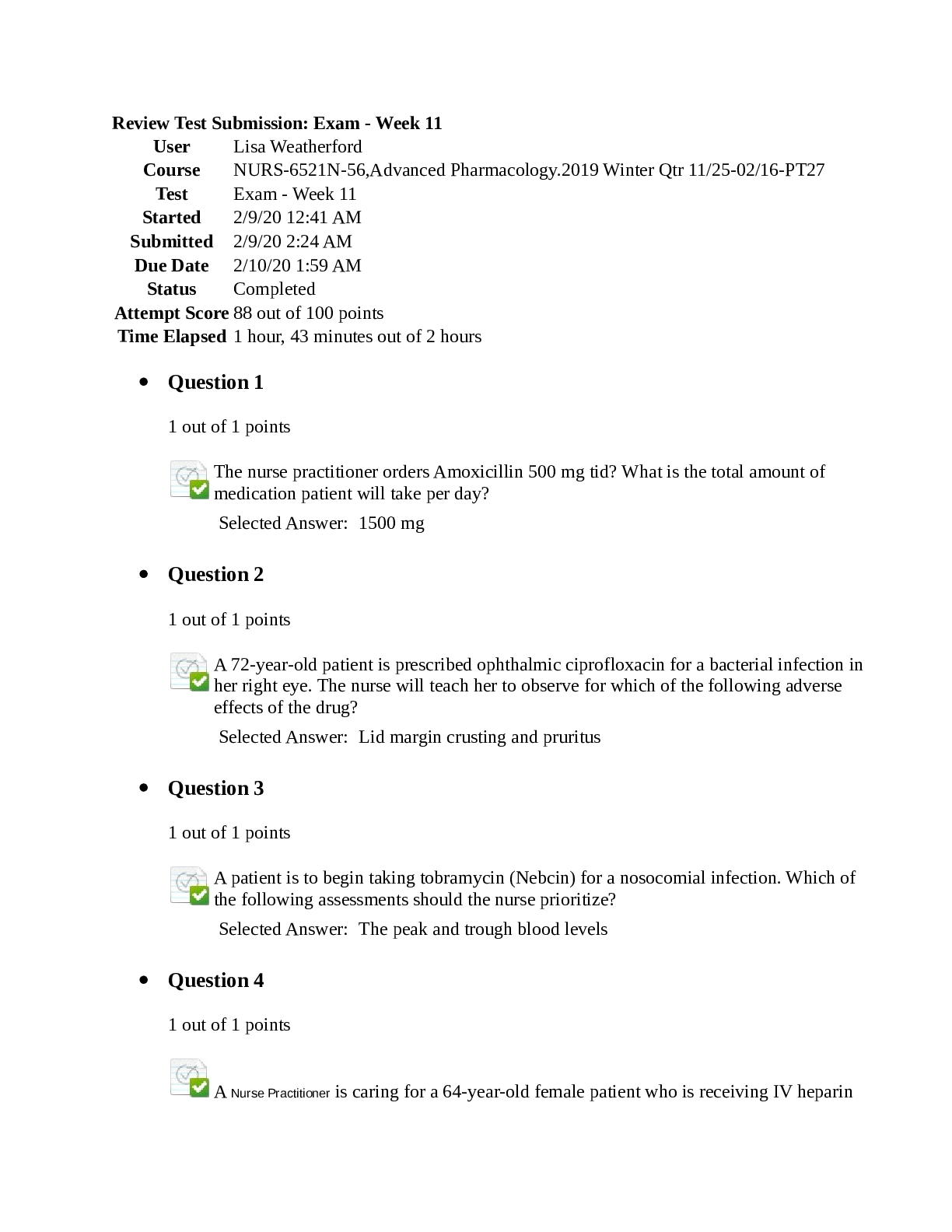*NURSING > EXAM > NURSING 6660: Final Exam Practice Chapter 36-59. Final Test Questions Submissions By Students. (All)
NURSING 6660: Final Exam Practice Chapter 36-59. Final Test Questions Submissions By Students.
Document Content and Description Below
Final Exam Practice Chapter 36-59 The most important action the nurse should do before and after suctioning a client is: a. Placing the client in a supine position b. Making sure that suctioning ta... kes only 10-15 seconds c. Evaluating for clear breath sounds d. Hyperventilating the client with 100% oxygen The position of a conscious client during suctioning is: a. Fowler's b. Supine position c. Side-lying d. Prone a. Fowler's Presence of overdistended and non-functional alveoli is a condition called: a. Bronchitis b. Emphysema c. Empyema d. Atelectasis Answer: B. The accumulation of fluids in the pleural space is called: a. Pleural effusion b. Hemothorax c. Hydrothorax d. Pyothorax a. Pleural effusion a. Do nothing, because this is an expected finding. b. Immediately clamp the chest tube and notify the physician. c. Check for an air leak because the bubbling should be intermittent. d. Increase the suction pressure so that bubbling becomes vigorous. The nurse caring for a male client with a chest tube turns the client to the side, and the chest tube accidentally disconnects. The initial nursing action is to: a. Call the physician. b. Place the tube in a bottle of sterile water. c. Immediately replace the chest tube system. d. Place the sterile dressing over the disconnection site. While changing the tapes on a tracheostomy tube, the male client coughs and the tube is dislodged. The initial nursing action is to: a. Call the physician to reinsert the tube. b. Grasp the retention sutures to spread the opening. c. Call the respiratory therapy department to reinsert the tracheotomy. d. Cover the tracheostomy site with a sterile dressing to prevent infection. b. Grasp the retention sutures to spread the opening. A nurse is caring for a male client immediately after removal of the endotracheal tube. The nurse reports which of the following signs immediately if experienced by the client? a. Stridor b. Occasional pink-tinged sputum c. A few basilar lung crackles on the right d. Respiratory rate of 24 breaths/min The nurse reports stridor to the physician immediately. This is a high-pitched, coarse sound that is heard with the stethoscope over the trachea. Stridor indicates airway edema and places the client at risk for airway obstruction An emergency room nurse is assessing a female client who has sustained a blunt injury to the chest wall. Which of these signs would indicate the presence of a pneumothorax in this client? . A low respiratory b. Diminished breathe sounds c. The presence of a barrel chest d. A sucking sound at the site of injury A nurse is caring for a male client hospitalized with acute exacerbation of chronic obstructive pulmonary disease. Which of the following would the nurse expect to note on assessment of this client? a. Hypocapnia b. A hyperinflated chest noted on the chest x-ray c. Increase oxygen saturation with exercise d. A widened diaphragm noted on the chest x-ray Clinical manifestations of chronic obstructive pulmonary disease (COPD) include hypoxemia, - hypercapnia, - dyspnea on exertion and at rest - oxygen desaturation with exercise - and the use of accessory muscles of respiration. Chest x-rays reveal a hyperinflated chest and a flattened diaphragm if the disease is advanced. A community health nurse is conducting an educational session with community members regarding tuberculosis. The nurse tells the group that one of the first symptoms associated with tuberculosis is: a. Dyspnea b. Chest pain c. A bloody, productive cough d. A cough with the expectoration of mucoid sputum One of the first pulmonary symptoms is a slight cough with the expectoration of mucoid sputum. Options A, B, and C are late symptoms and signify cavitation and extensive lung involvement. A nurse is caring for a male client with emphysema who is receiving oxygen. The nurse assesses the oxygen flow rate to ensure that it does not exceed: a. 1 L/min b. 2 L/min c. 6 L/min d. 10 L/min A nurse instructs a female client to use the pursed-lip method of breathing and the client asks the nurse about the purpose of this type of breathing. The nurse responds, knowing that the primary purpose of pursed-lip breathing is to: a. Promote oxygen intake. b. Strengthen the diaphragm. c. Strengthen the intercostal muscles. d. Promote carbon dioxide elimination. Nurse Hannah is preparing to obtain a sputum specimen from a client. Which of the following nursing actions will facilitate obtaining the specimen? a. Limiting fluids b. Having the clients take three deep breaths c. Asking the client to split into the collection container d. Asking the client to obtain the specimen after eating A nurse is caring for a female client after a bronchoscope and biopsy. Which of the following signs, if noted in the client, should be reported immediately to the physicians? a. Dry cough b. Hematuria c. Bronchospasm d. Blood-streaked sputum If a biopsy was performed during a bronchoscopy, blood-streaked sputum is expected for several hours. A nurse is suctioning fluids from a male client via a tracheostomy tube. When suctioning, the nurse must limit the suctioning time to a maximum of: a. 1 minute b. 5 seconds c. 10 seconds d. 30 seconds A nurse is suctioning fluids from a female client through an endotracheal tube. During the suctioning procedure, the nurse notes on the monitor that the heart rate is decreasing. Which of the following is the appropriate nursing intervention? a. Continue to suction. b. Notify the physician immediately. c. Stop the procedure and reoxygenate the client. d. Ensure that the suction is limited to 15 seconds. An unconscious male client is admitted to an emergency room. Arterial blood gas measurements reveal a pH of 7.30, a low bicarbonate level, a normal carbon dioxide level, a normal oxygen level, and an elevated potassium level. These results indicate the presence of: a. Metabolic acidosis b. Respiratory acidosis c. Overcompensated respiratory acidosis d. Combined respiratory and metabolic acidosis A female client is suspected of having a pulmonary embolus. A nurse assesses the client, knowing that which of the following is a common clinical manifestation of pulmonary embolism? a. Dyspnea b. Bradypnea c. Bradycardia d. Decreased respiratory A nurse teaches a male client about the use of a respiratory inhaler. Which action by the client indicates a need for further teaching? a. Inhales the mist and quickly exhales b. Removes the cap and shakes the inhaler well before use c. Presses the canister down with the finger as he breathes in d. Waits 1 to 2 minutes between puffs if more than one puff has been prescribed [Show More]
Last updated: 2 years ago
Preview 1 out of 10 pages

Buy this document to get the full access instantly
Instant Download Access after purchase
Buy NowInstant download
We Accept:

Reviews( 0 )
$5.00
Can't find what you want? Try our AI powered Search
Document information
Connected school, study & course
About the document
Uploaded On
Aug 20, 2020
Number of pages
10
Written in
Additional information
This document has been written for:
Uploaded
Aug 20, 2020
Downloads
0
Views
121

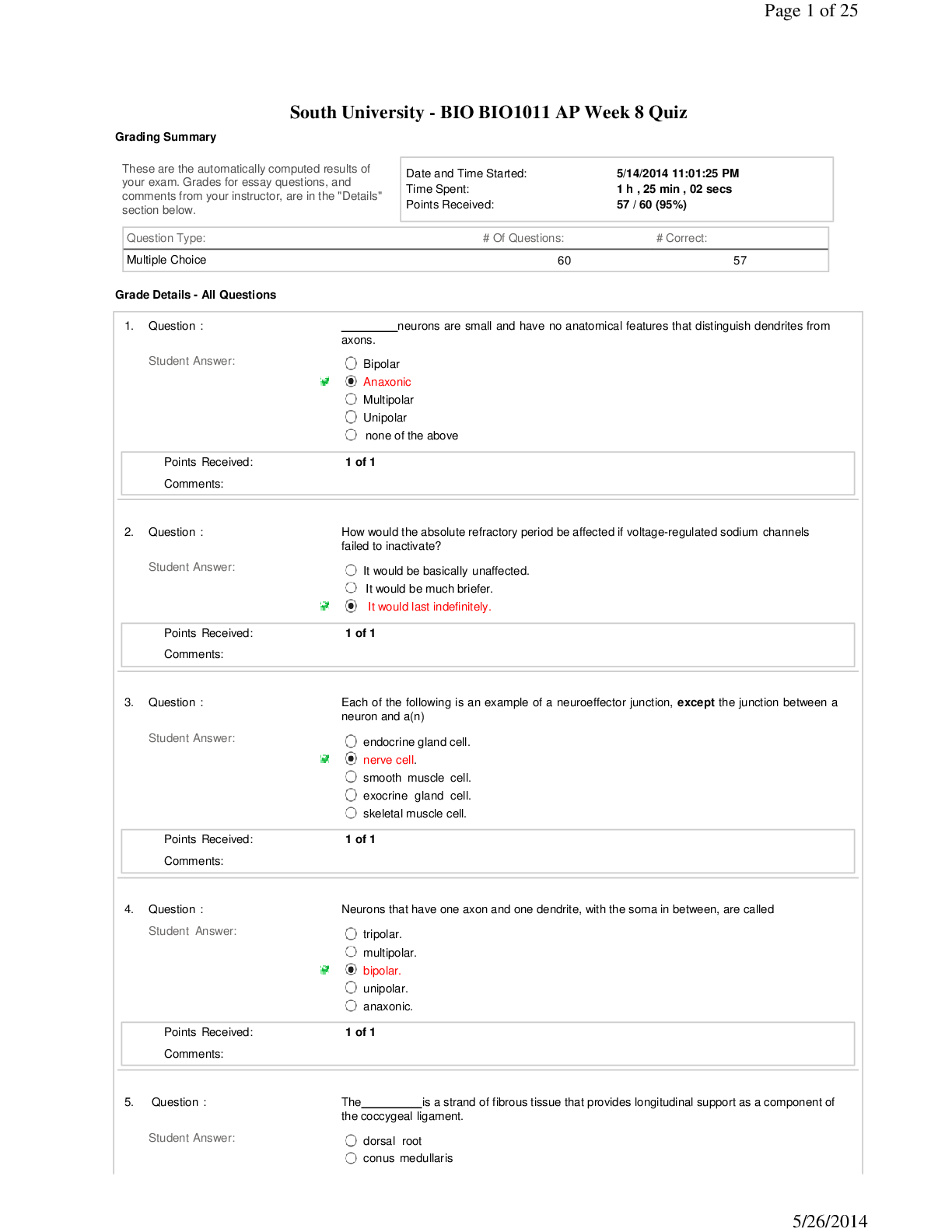
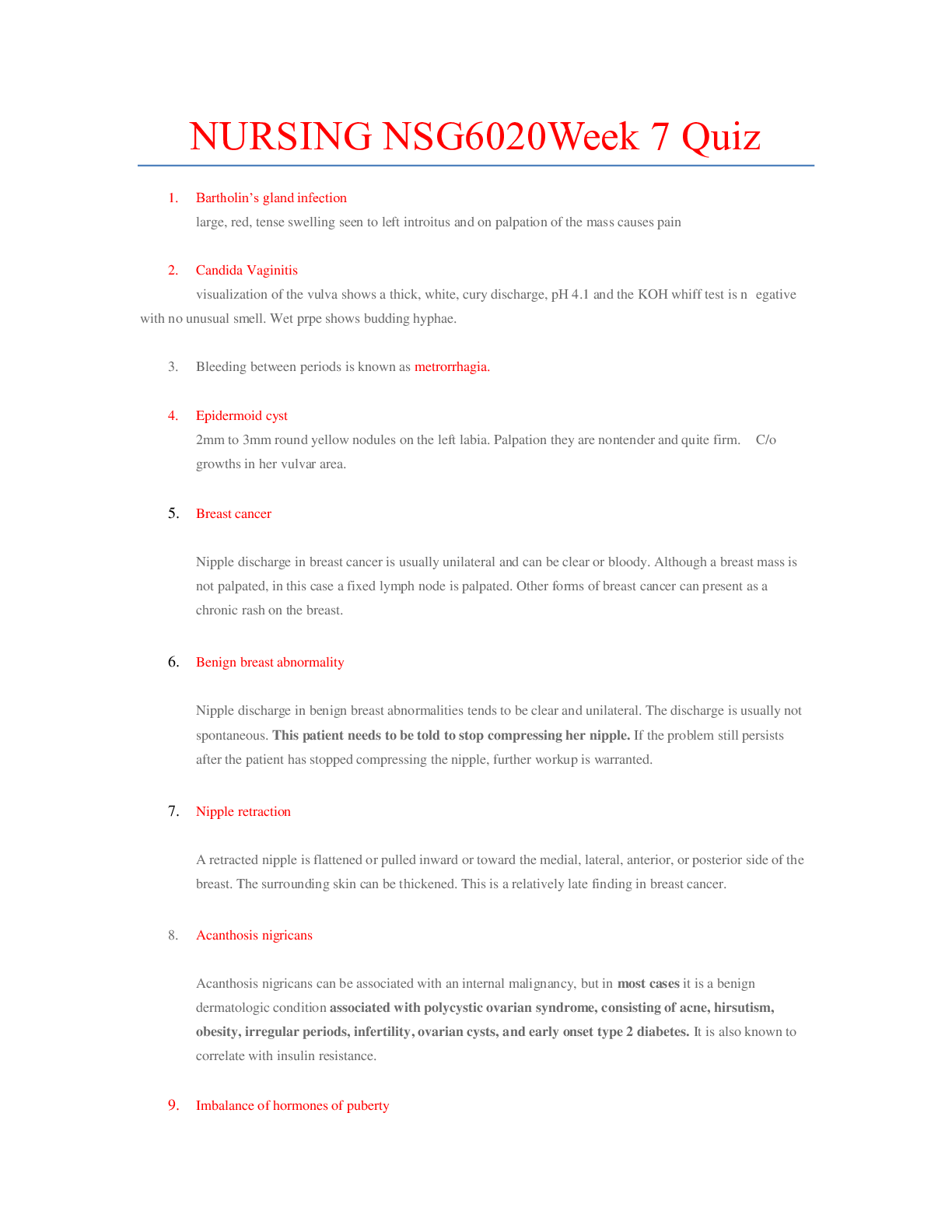
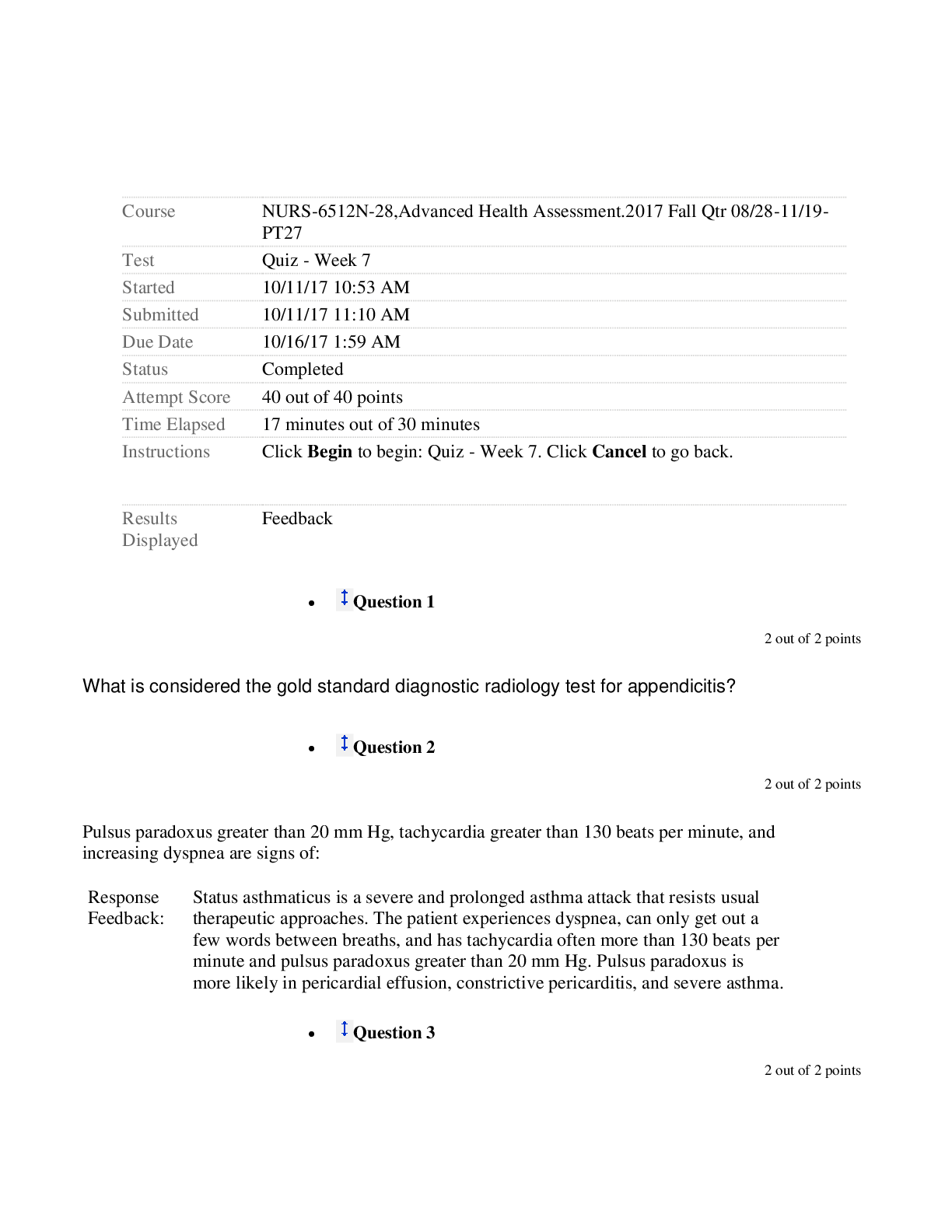



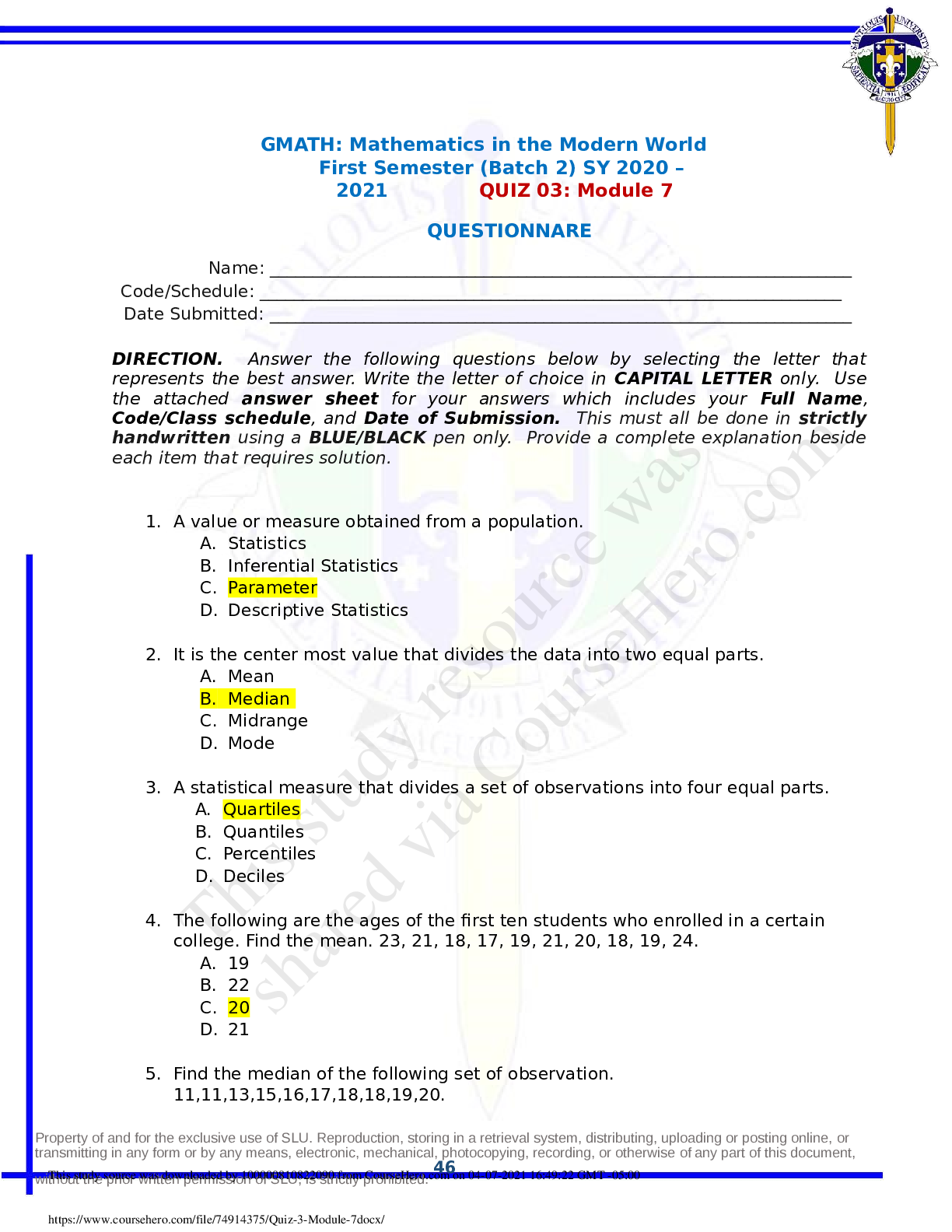



.png)





.png)


